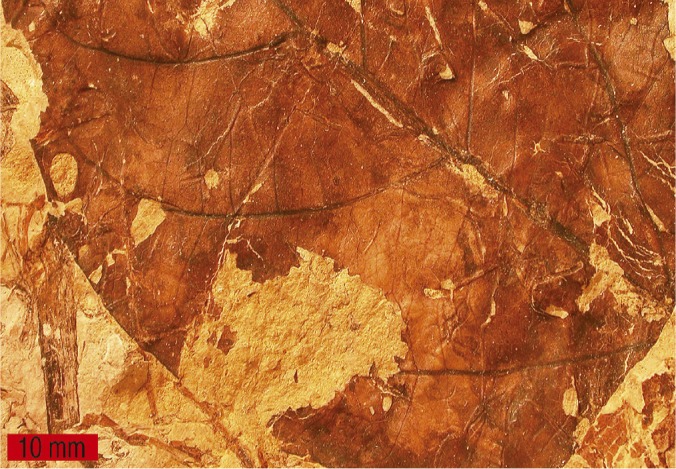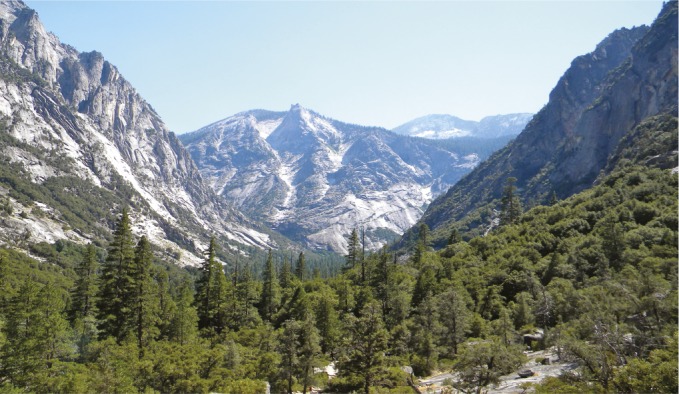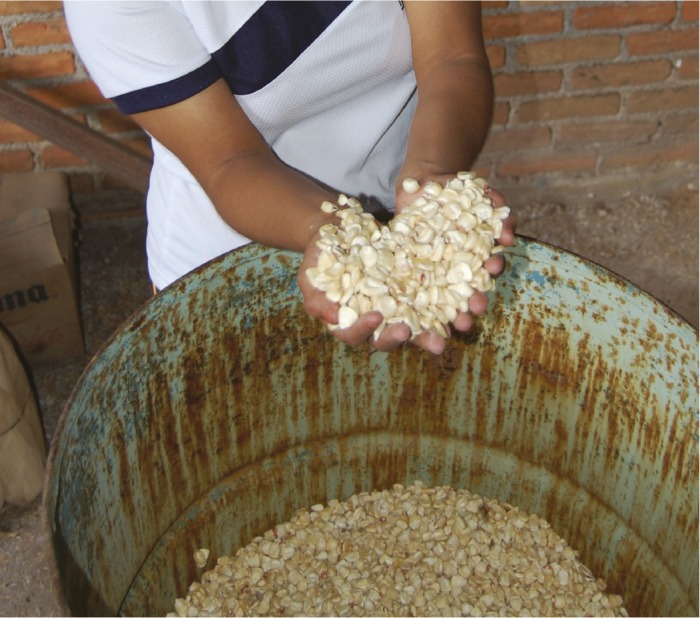Cretaceous climate change and the rise of angiosperms

Fossilized leaf of the Cretaceous-age angiosperm Viburnum lesquereuxii. Image courtesy of Wikimedia Commons/Wilson44691.
Angiosperms diversified quickly during the Cretaceous period, reshaping a world previously dominated by ferns and conifers. Anne-Claire Chaboureau et al. (pp. 14066–14070) simulated global climate changes during the break-up of the Pangea supercontinent to assess the possible influence of the changes on angiosperm expansion. Using ocean–atmosphere general circulation models, the authors observed increases in rainfall over continental land masses during the beginning of the Pangea break-up from the Triassic period to the late Cretaceous, bringing rain to areas that were previously arid deserts. Temperate biome area increased from 25% of simulated landmass 225 million years ago to more than 45% of simulated landmass by 95 million years ago. Further, the authors examined the locations of angiosperm fossil sites during the Cretaceous and noted that fossil sites became more diverse and geographically scattered over time and expanded into northern latitudes during the mid-Cretaceous period. According to the authors, the fraction of angiosperm fossil sites located in temperate biomes doubled between the Aptian and Cenomanian ages. The results suggest that abiotic factors, such as Cretaceous climate change, rising sea level, and the formation of isolated archipelagos, may have contributed to the sudden rise of angiosperm diversity, according to the authors. — P.G.
Influence of climate change on freshwater mountain runoff

Kings Canyon National Park. Image courtesy of Wikimedia Commons/Crd637.
Snow-dominated mountain forests that are dormant in winter due to cold temperatures are characterized by a lower vegetation density and less evapotranspiration (ET) than downslope forests that are located in the snow–rain transition zone and have a year-round growing season. Michael Goulden and Roger Bales (pp. 14071–14075) investigated the potential influence of a warming climate on ET in the upper Kings River basin in California’s Sierra Nevada Mountains, and potential changes in the amount of freshwater mountain runoff available to serve surrounding communities. The authors measured water vapor emission rates and combined the data with remote sensing imagery to determine the relationships between elevation, climate, and ET. According to the data, freshwater mountain runoff is highly sensitive to expansions in vegetation growth that may result from increased temperatures. Specifically, the 4.1 °C temperature rise that climate models predict may occur by 2100 would increase vegetation density at high elevations in the upper Kings River basin, resulting in ET increases as high as 28%, with a corresponding 26% decrease in river flow. Further, the relationships between ET, temperature, and vegetation density were similar across a broad area of the Sierra Nevada, suggesting that the impact of climate change on ET and freshwater availability might be widespread. — J.P.J.
Declining maize diversity

Young woman shows maize seed of the Ancho race.
The practice of saving seed on farms and passing the seed to succeeding generations exposes crops to natural selection and allows them to adapt and remain productive, with varietal diversity improving a crop’s chances of successful adaptation. George Dyer et al. (pp. 14094–14099) measured the diversity of maize varieties grown on 1,725 farms across Mexico between 2002 and 2007 to assess the degree of farm-based conservation of crop varieties. According to direct measurements, maize diversity decreased from 1.43 varieties to 1.22 varieties in 5 years. In contrast, indirect estimates from case studies showed an increase in varietal diversity, indicating that the indirect method may overestimate maize diversity and conceal loss of varieties. Further, direct measurements of varietal loss yielded similar results across regions and altitudes, even among farmers who grow maize continuously, suggesting that the phenomenon of decreasing diversity is widespread and enduring. According to the authors, decreasing diversity of actively grown maize varieties may limit crop adaptation to climate change, potentially resulting in reduced yields, farm abandonment, and further loss of crop diversity. Failure to conserve crop diversity in the face of climate change may also jeopardize food security efforts around the world, according to the authors. — J.P.J.
Population screening for high-risk cancer genes
Inherited predisposition to breast and ovarian cancer among many members of the Ashkenazi Jewish population is due to one of three mutations in either the BRCA1 or BRCA2 genes. Population-wide screening for the mutations requires an assessment of the cancer risk posed by these mutations to women in the general population. Efrat Gabai-Kapara et al. (pp. 14205–14210) identified mutation carriers regardless of family history. The authors screened more than 8,000 healthy Ashkenazi Jewish men for cancer-predisposing BRCA1 or BRCA2 mutations and identified female relatives of the 175 male carriers who were carriers themselves. About half of the families with BRCA1 or BRCA2 mutations had no significant history of breast or ovarian cancer. Cumulative risks for developing either cancer by age 60 and 80 were, respectively, 0.60 and 0.83 for female BRCA1 mutation carriers and 0.33 and 0.76 for BRCA2 mutation carriers. Women born after 1958 carried a 3.8-fold higher risk of developing breast or ovarian cancer by age 50 than those born before 1958, possibly due to improved screening and nongenetic risk factors. According to the authors, the results suggest that population-wide screening for BRCA1/BRCA2 mutations could identify women at high risk who would not have been identified by screening based only on family or personal history of cancer. — P.G.
Climate change and selection of temperature-dependent traits

Brown anole lizard. Image courtesy of Christian Cox.
Anthropogenic climate change poses a serious threat to tropical ectotherms such as reptiles and amphibians because of their narrow tolerance for environmental temperature changes. Evolutionary adaptation may prevent extinction, but whether climate change spurs the natural selection of certain thermoregulatory traits is unclear. Michael Logan et al. (pp. 14165–14169) explored the relationship between thermal physiology and natural selection in two populations of Anolis sagrei lizards from The Bahamas. The authors studied a reference population of 85 males from an unmanipulated population on Kidd Cay, Great Exuma, measuring the lizards’ survival as a function of their sprint speed at various environmental temperatures. To simulate how climate change might affect natural selection for thermal performance, the authors repeated the study in a population of 80 male lizards from the island of Eleuthera that had been transplanted from an interior, forested habitat to a warmer, more thermally variable site about 1 km away. The authors report evidence of strong natural selection favoring lizards that ran faster at higher temperatures and across a broad range of temperatures. According to the authors, rapid climate change can drive strong, directional selection on thermal physiology, even in species whose thermoregulatory behaviors are thought to shelter them from natural selection. — A.G.
Common neural code for shared conscious experiences
Evaluating human consciousness based on brain activity is a major challenge of modern neuroscience. In particular, it is unclear whether individuals sharing a conscious experience display a common neural code. Lorina Naci et al. (pp. 14277–14282) used functional MRI to examine neural activity in 12 healthy participants as well as two behaviorally unresponsive, brain-injured individuals with unknown levels of consciousness while the subjects viewed a movie by Alfred Hitchcock. The healthy participants displayed a common pattern of synchronized neural activity across the frontal and parietal brain regions, which are involved in high-level cognitive processes such as monitoring and analyzing information from the environment. Activity in the two brain regions was stronger during suspenseful movie frames, which imposed greater cognitive demands related to understanding the plot, compared with less suspenseful movie frames. Movie viewing evoked activity in the frontal and parietal regions of one of the two brain-injured individuals similar to that of healthy participants, indicating that the individual was consciously aware. According to the authors, the findings suggest a common neural basis of human consciousness that may enable the interpretation of conscious experience in the absence of observable behaviors. — J.W.


